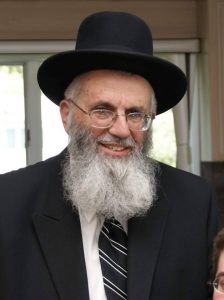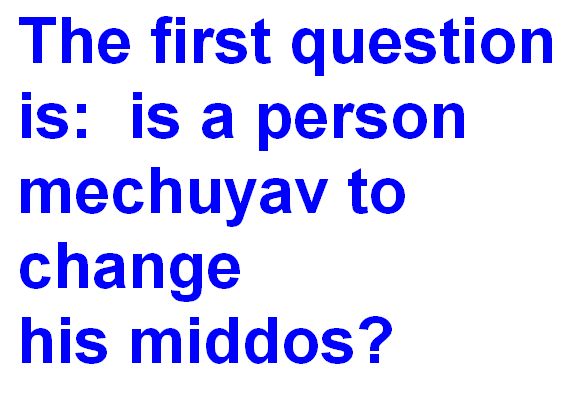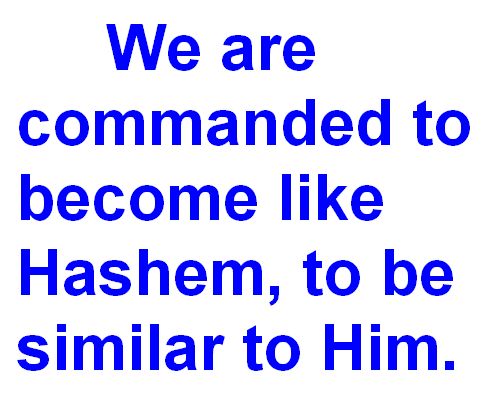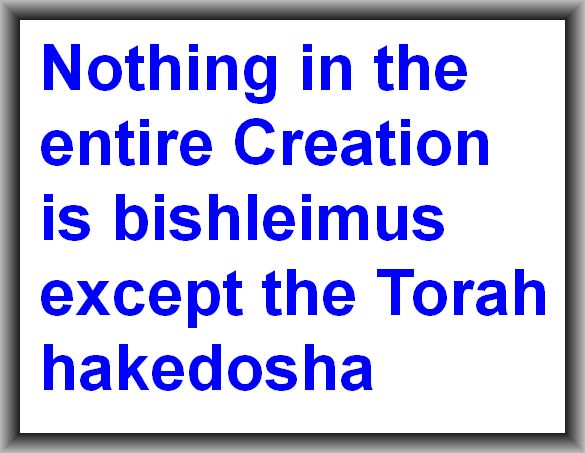| | NEWS
A Life's Work: Improving Our Middos
by HaRav Gershon Weiss zt"l

Improving ourselves is a task that is always in season, but it is especially appropriate as a preparation for kabolas haTorah. This essay and several more that will, iy'H, follow in the coming weeks, explains the basis for our obligation to work on improving our character, and the framework in which we should do so. One of the most important lessons is that we must turn to the Torah for guidance in middos — as in everything else in life. The following is based on tapes of shmuessen that were delivered at the Yeshiva of Staten Island. It was originally published in 1996.
Part I
It is very important to work on our middos. Each person must know that he or she has a chiyuv — a real obligation — to work on middos and he must be sure to do so.
A time that is especially appropriate to work on middos is during sefiras HaOmer. The gemara in Yevomos says: "Shneim osor elef zugim talmidim" — Rabbi Akiva had 12,000 pairs of talmidim, "vekulom meisu beperek echad mipnei shelo nohagu kovod zeh bozeh" — they all died in one time period because they did not treat each other bekovod.
They all died in such a short time to show clearly that it was something special, that the yad Hashem was in it. The reason that all these talmidim died was because they weren't michabeid each other enough. It was not that they chas vesholom were nohagu bibizayon to each other, but only because they did not give the proper kovod to each other.
A Tremendous Loss
Who were these talmidim who passed away? They were not beginners in learning. They were the gedolei hador and gedolei haposkim. After their passing, Chazal say, "Vehoya ha'olom shomeim" — the world was desolate because these 24,000 talmidim died. When one godol is niftar we know how we feel. Can we imagine what it is to lose 24,000 in a few short weeks?
This was in a time where there was only Torah shebe'al peh — there was no Shulchan Oruch, no Kitzur, nor even a Rif. The gemora and Mishna were not yet written down. Everything that you had to learn and know in order to live as a good Jew had to be taught to you by someone. In order to do anything, you had to know the halachos. If you wanted to eat a chicken, someone had to teach you how to kasher the chicken, how to recognize if something was treif. Nowadays we have a gemora and sifrei poskim with all the hilchos kashrus in one place. The same thing for all the other halachos. But it wasn't like that then.

The talmidim of Rabbi Akiva who died were the morei horo'oh of that dor. After they were gone, there was no one left to pasken. Nonetheless, for the Ribono Shel Olam it was worthwhile to remove this whole dor of gedolim and poskim — to start Torah anew — only because "shelo nohagu kovod zeh bozeh." Their Torah was not pure, it was Torah with a flaw in it. And the only way Torah got started again was because Rabbi Akiva went to "rabboseinu shebadarom." And through Rabbi Akiva who went to the darom and started teaching them, Torah was once again established in Klal Yisroel.
If someone would come and tell you that the Holocaust happened because talmidim didn't give each other enough kovod, you would say: How could that be? So many tzadikim and talmidim died only because they weren't so nice to each other? It doesn't seem to make sense.
But this is what the gemora says: "Shelo nohagu kovod." It was an issue of middos. If a ben Torah does not have proper kovod for his fellow, it is a reflection on his whole Torah.
It was also hard for Rabbi Akiva. He could have said, "I was a baal teshuva, an am ho'oretz. I worked very hard, taught Torah, and look! All my efforts went to waste."
It was a big nisoyon.
It is important for us to understand the background of Rabbi Akiva. He was 40 years old when he married his wife Rochel. Why did Rochel marry him?
Rochel was the daughter of a very rich man named Kalba Savua, who was known for his chesed. His name came from the word "kelev" — whoever went into his house hungry as a dog, "savua" — came out satisfied.
Kalba Savua wanted his daughter to marry a talmid chochom, but his daughter Rochel wanted Rabbi Akiva. She went to her father and told him that she wanted to marry Akiva — who was then a 40 year old am ho'oretz. He must been astonished at his daughter's ideas. He was a very rich man who understood the importance of Torah, and his daughter could probably have married many distinguished bnei Torah. But she wanted to marry Akiva!
The gemora says that Rochel saw that Akiva had middos tovos: he was pleasant and a tzanu'a. She saw that he could become great in Torah. She said I will make him into a talmid chochom. But this was not obvious when they were married. After their marriage, Kalba Savua disinherited them both. They had no fancy chasunah, and they lived in a barn with a little straw under them. Eliyahu Hanovi came to them and asked them if they had a little straw for someone who had given birth. Rabbi Akiva said, "See, someone is worse off than we are."
That was how the Torah of Rabbi Akiva started — because of his good middos and mesiras nefesh. When Rochel saw the middos tovos in Rabbi Akiva she was certain that he would be a talmid chochom.
After they got married, Rabbi Akiva went off to learn for 12 years, with his wife's permission. When he returned after 12 years, as he stood before the door he overheard his wife saying that she wouldn't mind if he stayed away another 12 years. So he turned around and went back to learn for another 12 years straight.
Why was it specifically the talmidim of Rabbi Akiva who were the ones to die because of "shelo nohagu kovod zeh bozeh." Were they worse than other talmidim in other doros?
The reason is because it was their rebbe, Rabbi Akiva, who was doreish, "Es Hashem Elokecha tirah, lerabos talmidei chachomim" — that the kovod of talmidei chachomim is in the same category as kovod Hashem. (Other talmidei chachomim disagreed with this.) Rabbi Akiva held that the kovod of a talmid chochom is very high and his talmidim, who saw this in their rebbe, should have achieved a higher level too, and given this immense kovod to each other. Thus, a lack of middos tovos caused a whole dor of Torah to be destroyed.
To this day, we recall this great calamity that befell Klal Yisroel in these weeks, and, since the problem was an issue of middos, it is important to understand and work on them especially at this time. It is apparent that our chachomim felt that it was of utmost importance for all generations to realize these lessons, and therefore they instituted the customs of aveilus in this period.

Must We Have Good Middos?
We have to look at some sources for working on middos and having middos tovos. The first question is — is a person mechuyav to change his middos?
What does "middos tovos" mean? Does it mean that simply that I should do chesed and give tzedaka, or maybe it also means that I should have a "geshmak" — I should want to do chesed, to give tzedaka.
For example, if someone grew up in Sodom he was taught that it was an aveira to give tzedaka since they believed that giving tzedaka made the recipient lazy. If he later went to Avrohom he saw a different hanhagah. His teva, from his youthful education, is that it hurts him to give tzedaka.
Is such a person mechuyav to change his teva to want to give tzedaka? Is a person supposed to say, "I want to give tzedaka not for my reward in olam haboh but because I want to help out the next person?" Or can a person say, "Hashem gave me certain tools and I will use them to serve Him. But am I mechuyav to change my middos? Is there any tzivui in the Torah to work on one's middos?"
The answer is that the whole sefer Bereishis speaks about middos. It talks about Avrohom, Yitzchok, and Yaakov and Eliezer the servant of Avrohom. The Torah tells at great length the whole story of Eliezer. Why? It is because Hashem wants us to learn proper middos from the whole story.
We are commanded to become like Hashem, to be similar to Him. The Rambam in his Sefer Hamitzvos says: "Shetzivonu lehisdamos Bo, yisborach, kefi hayecholes" — to become similar to Hashem according to one's capability to do so.
We have the mitzvah of "veholachta bedrochov." Hashem asks us to go in His ways. If Hashem is rachum we should also be rachum. If Hashem is chanun we should also be chanun. The gemora in Sotah says, "Acharei Hashem Elokeichem teileichu" — we should go "after" Hashem. The gemora asks, How can a person go after Hashem if, as it says, Hashem is "eish ochla hi"? The gemora answers that it means follow the middos of Hashem.
Just like Hashem was malbish arumim (it says that He made clothes for Adam and Chava), we should also be malbish arumim. Hashem did this even after Adam and Chava sinned, even at a time that we might think that they did not deserve His chesed.
Hashem was mevaker choleh as it says: "Vayeirah eilov Hashem be'Eilonei Mamrei." Hashem visited Avrohom after his milah. So we too must be mevaker choleh.
Hashem was menachem aveilim as it says: "Vayinachem es Yitzchok beno," after Avrohom died. We too must be menachem aveilim.
Hashem was kover meisim as it says: "Vayikover oso bagay." Hashem buried Moshe Rabbenu. We too must be kover meisim.
This gemora is saying that our actions should be like the actions of Hashem.

The gemora in Shabbos goes even further. It says that at krias yam Suf, Bnei Yisroel said: "Zeh Keili ve'anveihu." This means that our character must also be like Hashem: "anveihu" is "ani vohu". If Hashem is rachum vechanun we must also be rachum vechanun. The idea is not only to do the ma'asim of Hashem, but also — insofar as we are able — to be similar to Hashem.
These are the two things a person must work on. We have no hasogoh of Hashem, but the nevi'im gave us descriptions of Him like rachum and chanun, so we should be able to emulate these ways. The Chinuch says if one does not work on his ways to make them yeshorim, then he is mivateil this mitzvah.
People in America pay millions of dollars a year to try to change themselves. They go to psychiatrists and psychologists to change themselves, but there are no easy answers to their problems.
People like easy answers. If someone comes to you with a problem and you say I have a simple solution for you. Go to the wine store and buy 3 gallons of wine. Drink one for breakfast, one for lunch, and one for supper for 2 weeks and you will be OK. With this approach you will have lots of customers because it is an easy solution. But if you tell a person the whole parsha of middos and how to work on them — you won't have so many customers.
The main question is: Are we "customers" ourselves in changing our middos? Every person must ask himself this question.
The Rambam calls middos — hilchos dei'os. Why? A person has a lot of dei'os. Each day is different, each person is different. One is always angry, and another is always calm. There are a lot of opposite middos in people. Is a person born with these middos, or does a person acquire them? Where should he turn to acquire them?
The Source of Good Middos: Sinai
The Rambam in Shemoneh Perokim, his hakdomoh to Pirkei Ovos, says that masechta Ovos is a masechta of middos.
The meforshim in Mishnayos ask: Why does Pirkei Ovos start off with: "Moshe kibeil Torah miSinai umesoroh liYehoshua..." Why does Pirkei Ovos start off with the mesorah of kabolas haTorah?
The answer is because Pirkei Ovos talks about middos, and middos is a topic that many thinkers have also written about. Chazal are telling us here that the wisdom of Pirkei Ovos is not taken from human intelligence but it is halacha leMoshe miSinai. Only Hashem can tell us what our neshomoh needs. If we want to know what are proper middos are and how to develop them we need halacha leMoshe miSinai.
Only the Torah is Perfect
Chazal say that if the Torah had not been given to us, we could learn about gezel from an ant, about tsnius from a cat and about derech eretz from a rooster. If this is so, why do we need the Torah? Ants do not steal anything from their fellow ants, so why can't we learn middos from them?
I heard from Rav Kamyan, olov hasholom, that the reason is that, even though an ant will never steal from his fellow ant, where does the ant get his food from in the first place? The ant steals it from a man who worked very hard to plant it. The ant's observance of the prohibition of gezel is not perfect.
This is true all over: There is nothing in the entire Creation that is bishleimus except the Torah hakedosha. The Torah is the only thing that is perfect.
The rules of the Torah are not always what we might intuitively expect. If someone loses an aveidah and has lost all hope of recovering it and then you take it for yourself, I might think that you are a gazlan! You took his thing. But the Torah says you are not stealing in such a case.
On the other hand, what if I say: I washed my hands and now I need to wipe them. I will use someone else's towel. My hands are clean. I am sure that he won't mind. But the Torah says that in this case you are a gazlan.
To do what we should do bishleimus, we must learn what to do from the Torah. In every midda a person can go too far or not far enough, if he does not have the Torah's guidelines.
Sodom was a very highly developed community and they wanted their children to be successful. They wanted them to have gevurah and ambition. Their philosophy was that by giving tzedaka to someone, you are actually hurting him. Giving tzedaka creates lazy people. If you don't give him tzedaka, he will have to find a job, and once he starts working he will be happy, productive, raise good children and so on. This is a very attractive approach. If someone wrote a book based on it nowadays, it would definitely be a best-seller.
In Sodom, it was also the norm that if someone gave you a bloody nose you had to pay them. According to the accepted scientific wisdom of their day, people had too much blood and it was good to let some out. When Eliezer came someone gave him a bloody nose. He brought his attacker to court, and the judge said he had to pay the attacker. So Eliezer punched the judge in the nose, making it bleed, and said ok, now you owe me money so you can pay off my eved's attacker.
If middos are left to the unaided efforts of people, we could chas vesholom become like Sodom. In the end, Sodom got destroyed because they were rotten people who didn't do chesed.
HaRav Gershon Weiss was mashgiach of the Yeshiva of Staten Island.
|




